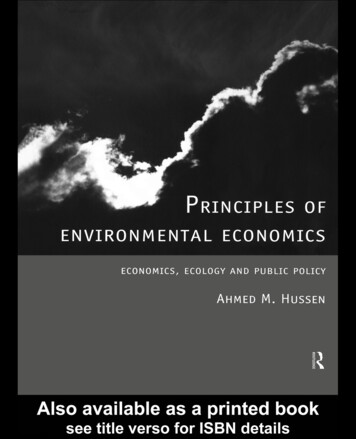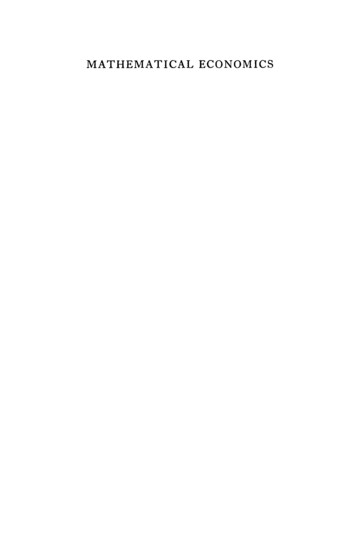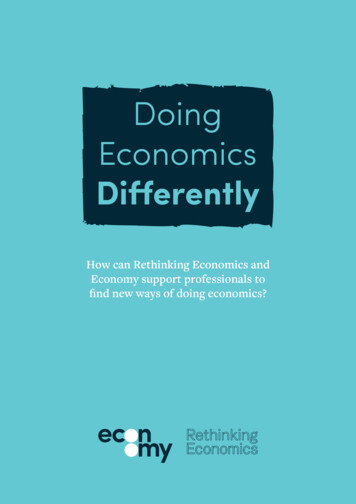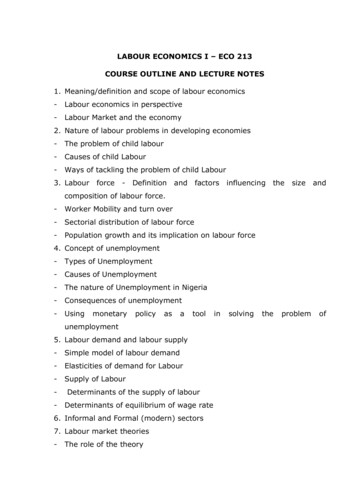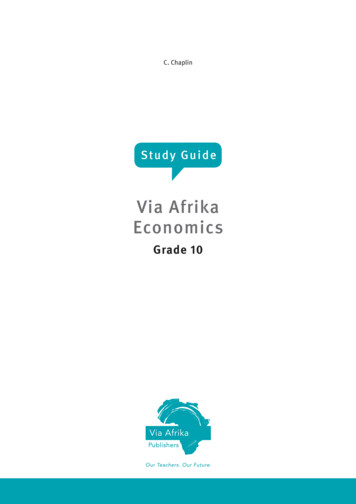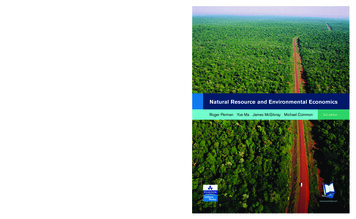
Transcription
Natural Resource and Environmental Economicswww.booksites.netRoger Perman Yue Ma James McGilvray Michael Common3rd edition3rd edition Substantial extensions to existing chapters,including a thorough account of game theoryand its application to internationalenvironmental problems; fuller treatments ofrenewable resource and forestry economics;and greater emphasis on spatial aspects ofpollution policy New pedagogical features includinglearning objectives, chapter summaries,further questions and more concise boxedcasesThis text has been written primarily for the specialistmarket of second and third year undergraduate andpostgraduate students of economics.Roger Perman is Senior Lecturer in Economics,Strathclyde University. His major research interests andpublications are in the field of applied econometrics andenvironmental economics.Yue Ma is Associate Professor in Economics, LingnanUniversity, Hong Kong, and Adjunct Professor of LingnanCollege, Zhongshan University, China. His major researchinterests are international banking and finance, as well asenvironmental economics for developing countries.New accompanying website atwww.booksites.net/perman provides a richvariety of resources for both lecturers andstudents Case studies and examples are usedextensively, highlighting the application oftheory Further readings, discussion questions andproblems conclude each chapter Detailed mathematical analysis is coveredin appendices to the relevant chapters Writing style and technical level have beenmade more accessible and consistentThe late James McGilvray was Professor of Economics atStrathclyde University. He made important contributions inthe fields of input-output analysis, social accounting andeconomic statistics, and to the study of the economics oftransition in Central and Eastern Europe.Cover Image Getty Imageswww.booksites.netwww.pearsoneduc.comMichael CommonMichael Common is Professor in the Graduate School ofEnvironmental Studies at Strathclyde University. His majorresearch interests are the development of ecologicaleconomics and policies for sustainability. James McGilvrayNew chapters on pollution control withimperfect information; cost-benefit analysisand other project appraisal tools; and stockpollution problemsYue Ma Natural Resource and Environmental EconomicsFeatures:Roger PermanNatural Resource and Environmental Economics isamong the leading textbooks in its field. Well written andrigorous in its approach, this third edition follows in the veinof previous editions and continues to provide a comprehensive and clear account of the application of economicanalysis to environmental issues. The new edition retains allof the topics from the second edition but has beenreorganised into four Parts: I Foundation II EnvironmentalPollution III Project Appraisal IV Natural ResourceExploitation.Natural Resource and Environmental EconomicsRoger Perman Yue Ma James McGilvray Michael Common3rd editionwww.booksites.net
Natural Resourceand EnvironmentalEconomicsThird EditionRoger PermanYue MaJames McGilvrayMichael Common
Pearson Education LimitedEdinburgh GateHarlowEssex CM20 2JEand Associated Companies throughout the worldVisit us on the World Wide Web at:www.pearsoneduc.comFirst published 1996 Longman Group LimitedSecond edition 1999 Addison Wesley Longman LimitedThird edition 2003 Pearson Education Limited Longman Group Limited 1996 Addison Wesley Longman Limited 1999 Pearson Education Limited 2003The rights of Roger Perman, Yue Ma, James McGilvray andMichael Common to be identified as the authors of this workhave been asserted by them in accordance with the Copyright,Designs and Patents Act 1988.All rights reserved. No part of this publication may be reproduced, stored in aretrieval system, or transmitted in any form or by any means, electronic, mechanical,photocopying, recording or otherwise, without either the prior written permission of thepublisher or a licence permitting restricted copying in the United Kingdom issued by theCopyright Licensing Agency Ltd, 90 Tottenham Court Road, London W1P 0LP.ISBN 0273655590British Library Cataloguing-in-Publication DataA catalogue record for this book is available from the British LibraryLibrary of Congress Cataloging-in-Publication DataNatural resource and environmental economics / Roger Perman . . . [et al.].—3rd ed.p. cm.Rev. ed. of: Natural resource and environmental economics / Roger Perman,Yue Ma, James McGilvray. 1996.Includes bibliographical references and index.ISBN 0-273-65559-0 (pbk.)1. Environmental economics. 2. Natural resources—Management.3. Sustainable development. I. Perman, Roger, 1949– Natural resource andenvironmental economics.HC79.E5 P446 2003333.7—dc2110 9 8 7 606 05 04 03520020425674321Typeset in 9.75/12pt Times by 35Printed and bound by Ashford Colour Press Ltd., Gosport
ContentsPreface to the Third EditionPart IChapter 11.11.21.31.4Chapter 22.12.22.32.42.5Chapter oundationsAn introduction to natural resource and environmentaleconomics3Learning objectivesIntroductionThree themesThe emergence of resource and environmental economicsFundamental issues in the economic approach to resourceand environmental issuesReader’s guideSummaryFurther reading333410121415The origins of the sustainability problem16Learning objectivesIntroductionEconomy–environment interdependenceThe drivers of environmental impactPoverty and inequalityLimits to growth?The pursuit of sustainable developmentSummaryFurther readingDiscussion questionsProblems1616172841444852525454Ethics, economics and the environment56Learning objectivesIntroduction5656
viContents3.13.23.33.43.5Chapter 44.14.24.34.44.5Chapter 5Part I5.15.25.35.4Part II5.55.65.7Part III5.85.95.105.115.125.13Naturalist moral philosophiesLibertarian moral philosophyUtilitarianismCriticisms of utilitarianismIntertemporal distributionSummaryFurther readingDiscussion questionsProblemsAppendix 3.1 The Lagrange multiplier method ofsolving constrained optimisation problemsAppendix 3.2 Social welfare maximisation575859646775757677Concepts of sustainability82Learning objectivesIntroductionConcepts and constraintsEconomists on sustainabilityEcologists on sustainabilityThe institutional conceptionSustainability and policySummaryFurther readingDiscussion questionsProblems82828386929697103103104104Welfare economics and the environment105Learning objectivesIntroductionEfficiency and optimalityEconomic efficiencyAn efficient allocation of resources is not uniqueThe social welfare function and optimalityCompensation testsAllocation in a market economyEfficiency given ideal conditionsPartial equilibrium analysis of market efficiencyMarket allocations are not necessarily equitableMarket failure, public policy and the environmentThe existence of markets for environmental servicesPublic goodsExternalitiesThe second-best problemImperfect informationGovernment failureSummaryFurther readingDiscussion questionsProblemsAppendix 5.1 Conditions for efficiency and 261341421431441451461461461477780
ContentsAppendix 5.2 Market outcomesAppendix 5.3 Market failure152153Part IIEnvironmental pollutionChapter 6Pollution control: targets165Learning objectivesIntroductionModelling pollution mechanismsPollution flows, pollution stocks, and pollution damageThe efficient level of pollutionA static model of efficient flow pollutionModified efficiency targetsEfficient levels of emissions of stock pollutantsPollution control where damages depend on locationof the emissionsAmbient pollution standardsIntertemporal analysis of stock pollutionVariable decayConvexity and non-convexity in damage and abatementcost functionsEstimating the costs of abating pollutionChoosing pollution targets on grounds other thaneconomic efficiencySummaryFurther readingDiscussion questionsProblemsAppendix 6.1 Matrix algebraAppendix 6.2 Spatially differentiated stock pollution:a numerical .76.86.96.106.116.126.13Chapter 96196201Pollution control: instruments202Learning objectivesIntroductionCriteria for choice of pollution control instrumentsCost efficiency and cost-effective pollution abatementinstrumentsInstruments for achieving pollution abatement targetsEconomic incentive (quasi-market) instrumentsPollution control where damages depend on locationof the emissionsA comparison of the relative advantages of commandand control, emissions tax, emission abatement subsidyand marketable permit instrumentsSummaryFurther readingDiscussion questions202202203204206217228234238239240vii
viiiContentsChapter 88.18.28.38.4Chapter 99.19.29.39.4Chapter 1010.110.210.310.410.510.610.710.8ProblemsAppendix 7.1 The least-cost theorem and pollutioncontrol instruments241242Pollution policy with imperfect information247Learning objectivesIntroductionDifficulties in identifying pollution targets in the contextof limited information and uncertaintySustainability-based approaches to target setting and theprecautionary principleThe relative merits of pollution control instrumentsunder conditions of uncertaintyTransactions costs and environmental regulationSummaryFurther readingDiscussion de modelling269Learning objectivesIntroductionInput–output analysisEnvironmental input–output analysisCosts and pricesComputable general equilibrium modelsSummaryFurther readingDiscussion questionsProblemsAppendix 9.1 A general framework for environmentalinput–output analysisAppendix 9.2 The algebra of the two-sector CGE model269269270274278281290290290291International environmental problems297Learning objectivesIntroductionInternational environmental cooperationGame theory analysisFactors contributing to enhancing probability of internationalagreements or achieving a higher degree of cooperationInternational treaties: conclusionsAcid rain pollutionStratospheric ozone depletionThe greenhouse effectInternational trade and the environmentLearning outcomesFurther readingDiscussion 9342343345
ContentsProblemsAppendix 10.1 Some algebra of international treatiesPart IIIChapter 1111.111.211.3Chapter 1212.112.212.312.412.512.6Chapter 1313.113.213.313.413.513.6346346Project appraisalCost–benefit analysis351Learning objectivesIntroductionIntertemporal welfare economicsProject appraisalCost–benefit analysis and the environmentSummaryFurther readingDiscussion questionsProblemsAppendix 11.1 Conditions for intertemporal efficiencyand optimalityAppendix 11.2 Markets and intertemporal allocation351351352362373385386387387Valuing the environment399Learning objectivesIntroductionDimensions of valueThe theory of environmental valuationEnvironmental valuation techniquesThe travel cost methodContingent valuationOther techniquesSummaryFurther readingDiscussion questionsProblemsAppendix 12.1 Demand theory and environmental rreversibility, risk and uncertainty444Learning objectivesIntroductionIndividual decision making in the face of riskOption price and option valueRisk and irreversibilityEnvironmental cost–benefit analysis revisitedDecision theory: choices under uncertaintyA safe minimum standard of conservationSummaryFurther readingDiscussion 466388395ix
xContentsAppendix 13.1 Irreversibility and development:future knownAppendix 13.2 Irreversibility, development and riskPart IVChapter 14Part I14.114.214.314.414.5Part II14.614.714.814.9Chapter 1515.115.215.315.415.5467468Natural resource exploitationThe efficient and optimal use of natural resources473Learning objectivesIntroductionA simple optimal resource depletion modelThe economy and its production functionIs the natural resource essential?What is the elasticity of substitution between K and R?Resource substitutability and the consequences ofincreasing resource scarcityThe social welfare function and an optimal allocation ofnatural resourcesExtending the model to incorporate extraction costs andrenewable resourcesThe optimal solution to the resource depletion modelincorporating extraction costsGeneralisation to renewable resourcesComplicationsA numerical application: oil extraction and globaloptimal consumptionSummaryFurther readingDiscussion questionsProblemsAppendix 14.1 The optimal control problem and itssolution using the maximum principleAppendix 14.2 The optimal solution to the simpleexhaustible resource depletion problemAppendix 14.3 Optimal and efficient extraction orharvesting of a renewable or non-renewable resourcein the presence of resource extraction costs473473474474474475The theory of optimal resource extraction:non-renewable resourcesLearning objectivesIntroductionA non-renewable resource two-period modelA non-renewable resource multi-period modelNon-renewable resource extraction in perfectlycompetitive marketsResource extraction in a monopolistic marketA comparison of competitive and monopolisticextraction 04506506506510512517518518
Contents15.615.715.815.915.10Chapter 1616.116.216.316.4Chapter .12Extensions of the multi-period model of non-renewableresource depletionThe introduction of taxation/subsidiesThe resource depletion model: some extensions andfurther issuesDo resource prices actually follow the Hotelling rule?Natural resource scarcitySummaryFurther readingDiscussion questionsProblemsAppendix 15.1 Solution of the multi-period resourcedepletion modelAppendix 15.2 The monopolist’s profit-maximisingextraction programmeAppendix 15.3 A worked numerical example535536Stock pollution problems537Learning objectivesIntroductionAn aggregate dynamic model of pollutionA complication: variable decay of the pollution stockSteady-state outcomesA model of waste accumulation and disposalSummaryFurther readingDiscussion able resources555Learning objectivesIntroductionBiological growth processesSteady-state harvestsAn open-access fisheryThe dynamics of renewable resource harvestingSome more reflections on open-access fisheriesThe private-property fisheryDynamics in the PV-maximising fisheryBringing things together: the open-access fishery,static private-property fishery and PV-maximisingfishery models comparedSocially efficient resource harvestingA safe minimum standard of conservationResource harvesting, population collapses and the extinctionof speciesRenewable resources policySummaryFurther readingDiscussion 5xi
xiiContentsChapter 1818.118.218.318.418.518.618.7Chapter 1919.119.219.319.419.5Appendix 17.1 The discrete-time analogue of thecontinuous-time fishery models examined in Chapter 17596Forest resources598Learning objectivesIntroductionThe current state of world forest resourcesCharacteristics of forest resourcesCommercial plantation forestryMultiple-use forestrySocially and privately optimal multiple-use plantation forestryNatural forests and deforestationGovernment and forest resourcesSummaryFurther readingDiscussion questionsProblemsAppendix 18.1 Mathematical derivationsAppendix 18.2 The length of a forest rotation in theinfinite-rotation model: some comparative ccounting for the environment626Learning objectivesIntroductionEnvironmental indicatorsEnvironmental accounting: theoryEnvironmental accounting: practiceSustainability indicatorsConcluding remarksFurther readingDiscussion questionsProblemsAppendix 19.1 National income, the return on wealth,Hartwick’s rule and sustainable incomeAppendix 19.2 Adjusting national income measurementto account for the environmentAppendix 19.3 The UNSTAT ences671Index689623660
PART IIEnvironmental pollution
CHAPTER 6Pollution control: targetsThe use of coal was prohibited in London in 1273, and at least one person was put to deathfor this offense around 1300. Why did it take economists so long to recognize and analyze theproblem?Fisher (1981), p. 164Learning objectivesAt the end of this chapter, the reader should beable tonunderstand the concept of a pollutiontargetnappreciate that many different criteriacan be used to determine pollutiontargetsnunderstand that alternative policyobjectives usually imply different pollutiontargetsnunderstand how in principle targets may beconstructed using an economic efficiencycriterionnunderstand the difference between flow andstock pollutantsnanalyse efficient levels of flow pollutants andstock pollutantsnappreciate the importance of the degree ofmixing of a pollutant stocknrecognise and understand the role of spatialdifferentiation for emissions targets1In Chapter 5 we showed that identification of an optimal allocation requires, among other things, knowledge of an appropriatesocial welfare function, and of production technologies and individual preferences throughout the whole economy. Moreover, evenif such an allocation could be identified, attaining it might involvesubstantial redistributions of wealth.2If you are unclear about the difference between optimality andefficiency it might be sensible to look again at Chapter 5. It is worthIntroductionIn thinking about pollution policy, the economist isinterested in two major questions. How much pollution should there be? And, given that some targetlevel has been chosen, what is the best method ofachieving that level? In this chapter we deal with thefirst of these questions; the second is addressed inthe next chapter.How much pollution there should be depends onthe objective that is being sought. Many economistsregard economic optimality as the ideal objective.This requires that resources should be allocated soas to maximise social welfare. Associated with thatallocation will be the optimal level of pollution.However, the information required to establish theoptimal pollution level is likely to be unobtainable,and so that criterion is not feasible in practice.1 Asa result, the weaker yardstick of economic efficiency is often proposed as a way of setting pollutiontargets.2recalling that the efficiency criterion has an ethical underpinningthat not all would subscribe to, as it implicitly accepts the prevailing distribution of wealth. We established in Chapter 5 that efficientoutcomes are not necessarily optimal ones. Moreover, moving froman inefficient to an efficient outcome does not necessarily lead toan improvement in social well-being.
166Environmental pollutionThe use of efficiency as a way of thinking abouthow much pollution there should be dates back tothe work of Pigou, and arose from his development of the concept of externalities (Pigou, 1920).Subsequently, after the theory of externalities hadbeen extended and developed, it became the mainorganising principle used by economists whenanalysing pollution problems.In practice, much of the work done by economistswithin an externalities framework has used a partialequilibrium perspective, looking at a single activity(and its associated pollution) in isolation from therest of the system in which the activity is embedded.There is, of course, no reason why externalities cannot be viewed in a general equilibrium framework,and some of the seminal works in environmentaleconomics have done so. (See, for example, Baumoland Oates, 1988, and Cornes and Sandler, 1996.)This raises the question of what we mean by the‘system’ in which pollution-generating activitiesare embedded. The development of environmentaleconomics and of ecological economics as distinctdisciplines led some writers to take a comprehensiveview of that system. This involved bringing thematerial and biological subsystems into the picture,and taking account of the constraints on economy–environment interactions.One step in this direction came with incorporatingnatural resources into economic growth models. Thenpollution can be associated with resource extraction and use, and best levels of pollution emergein the solution to the optimal growth problem.Pollution problems are thereby given a firm materialgrounding and policies concerning pollution levelsand natural resource uses are linked. Much of thework done in this area has been abstract, at a highlevel of aggregation, and is technically difficult.Nevertheless, we feel it is of sufficient importance towarrant study, and have devoted Chapter 16 to it.3There have been more ambitious attempts to usethe material balance principle (which was explainedin Chapter 2) as a vehicle for investigating pollution problems. These try to systematically modelinteractions between the economy and the environment. Production and consumption activities drawupon materials and energy from the environment.Residuals from economic processes are returned tovarious environmental receptors (air, soils, biota andwater systems). There may be significant delays inthe timing of residual flows from and to the environment. In a growing economy, a significant part of thematerials taken from the environment is assembledin long-lasting structures, such as roads, buildingsand machines. Thus flows back to the natural environment may be substantially less than extractionfrom it over some interval of time. However, in thelong run the materials balance principle points toequality between outflows and inflows. If we definedthe environment broadly (to include human-madestructures as well as the natural environment) theequality would hold perfectly at all times. Whilethe masses of flows to and from the environmentare identical, the return flows are in different physical forms and to different places from those of theoriginal, extracted materials. A full development ofthis approach goes beyond what we are able to coverin this book, and so we do not discuss it further(beyond pointing you to some additional reading).Economic efficiency is one way of thinking aboutpollution targets, but it is certainly not the only way.For example, we might adopt sustainability as thepolicy objective, or as a constraint that must besatisfied in pursuing other objectives. Then pollutionlevels (or trajectories of those through time) wouldbe assessed in terms of whether they are compatible with sustainable development. Optimal growthmodels with natural resources, and the materialsbalance approach just outlined, lend themselves wellto developing pollution targets using a sustainability criterion. We will show later (in Chapters 14, 16and 19) that efficiency and sustainability criteria donot usually lead to similar recommendations aboutpollution targets.Pollution targets may be, and in practice often are,determined on grounds other than economic efficiency or sustainability. They may be based on whatrisk to health is deemed reasonable, or on what isacceptable to public opinion. They may be based onwhat is politically feasible. In outlining the politicaleconomy of regulation in Chapter 8, we demonstrate3Our reason for placing this material so late in the text ispedagogical. The treatment is technically difficult, and is bestdealt with after first developing the relevant tools in Chapters 14and 15.
Pollution control: targetsthat policy is influenced, sometimes very strongly, bythe interplay of pressure groups and sectional interests. Moreover, in a world in which the perceivedimportance of international or global pollution problems is increasing, policy makers find themselvessetting targets within a network of obligations andpressures from various national governments andcoalitions. Pollution policy making within this international milieu is the subject of Chapter 10.In the final analysis, pollution targets are rarely, ifever, set entirely on purely economic grounds. Standards setting is usually a matter of trying to attainmultiple objectives within a complex institutionalenvironment. Nevertheless, the principal objectiveof this chapter is to explain what economics has tosay about determining pollution targets.6.1Modelling pollution mechanismsBefore going further, it will be instructive to develop a framework for thinking about how pollutionemissions and stocks are linked, and how theserelate to any induced damage. An example is usedto help fix ideas. Box 6.1 outlines the stages, andsome characteristics, of the oil fuel cycle. It illustrates the material and energy flows associated withthe extraction and transportation of oil, its refiningand burning for energy generation, and the subsequent transportation and chemical changes of theresiduals in this process.The contents of Box 6.1 lead one to consider several important ideas that will be developed in thisBox 6.1 The oil-to-electricity fuel cycleFigure 6.1 describes the process steps of theoil-to-electricity fuel cycle. At each of thesesteps, some material transformation occurs,with potential for environmental, health andother damage.The task given to the ExternE researchteam was, among other things, to estimate theexternal effects of power generation in Europe.A standard methodology framework – calledthe Impact Pathway Methodology – was devisedfor this task. The stages of the impact pathwayare shown on the left-hand side of Figure 6.2.Each form of pollutant emission associatedwith each fuel cycle was investigated in thisstandard framework. One example of this, forone pollutant and one kind of impact of thatpollutant, is shown on the right-hand side ofFigure 6.2; coal use results in sulphur dioxideemissions, which contribute to acidification ofair, ground and water systems.An indication of the pervasiveness of impactsand forms of damage is shown in Table 6.1,which lists the major categories of damagesarising from the oil-to-electricity fuel cycle. Infact, ExternE identified 82 sub-categories of theitems listed in Table 6.1. It attempted to measureeach of these 82 impacts for typical oil-firedpower stations in Europe, and place a monetaryvalue on each sub-category.ExternE (1995) compiled a detailed summaryof its estimates of the annual total damageimpacts of one example of an oil fuel cycleFigure 6.1 Process steps of the oil-to-electricityfuel cycleSource: ExternE (1995), figure 3.1, p. 30167
168Environmental pollutionBox 6.1 continuedTable 6.2 ExternE estimates of the damage impactsof two power stationsCategoryTotalAll OtherDeathOther human health0.782618.43624.30331Grand Total23.5221CategoryTotalAll OtherDeathOther human healthGrand Total3.33%78.38%18.29%100.00%Source: ExternE (1995), as compiled in the Excelworkbook ExternE.xls. Full definitions of units andvariables are given thereFigure 6.2 The impact pathways methodology and oneexampleSource: Adapted from ExternE (1995), figure 1, p. iiiTable 6.1 Major categories of damage arising fromthe oil-to-electricity fuel cycleDamage categoryOil spills on marine ecosystemsPublic health:Acute mortalityAcute morbidityOzoneChronic morbidityOccupational healthAgricultureForestsMaterialsNoiseGlobal warmingSource: Adapted from ExternE (1995)(the Lauffen power plant, Germany, employinga peak-load gas turbine plant operated withlight fuel-oil and a base load combined cycleplant using heavy fuel-oil). Given its size –about 100 individual categories of impact areidentified – we have chosen to present thesefindings separately, in the Excel workbookExternE.xls in the Additional Materials forChapter 6. For convenience, the Excel tablealso contains damage estimates for one exampleof a natural gas fuel cycle (the West Burtonpower station, a 652 MW Combined Cycle GasTurbine Plant in the East Midlands of the UK).Data is shown in currency units of mecu(milli-ecu, or 0.001 ecu; at 1992 exchange rates US 1.25 1 ecu).It is useful to study this material for tworeasons. First, it shows the huge breadth of typesof pollution impact, and the great attention todetail given in well-funded research studies.Second, as Table 6.2 demonstrates, estimates ofpollution damages are often dominated by valuesattributed to human mortality impacts. The datain Table 6.2 shows the sums of annual combinedimpacts of the two example power stations(expressed in units of mecu/kWh) for three verybroad impact categories, and then in terms ofpercentages of total impact. Impacts on humanmortality constitute over 78% of the identifiedand quantified impacts. It should be pointed outthat the figures shown were arrived at when theExternE analysis was incomplete; in particular,little attention had been given to greenhousewarming impacts of CO2 emissions. Nevertheless,the figures here illustrate one property that iscommon to many impact studies: human healthimpacts account for a large proportion of thetotal damage values. Given that valuation ofhuman life is by no means straightforward(as we shall indicate in Chapter 12), estimatesproduced by valuation studies can often behighly contentious.
Pollution control: targetsportion of the emission flows from economic activityis quickly absorbed and transformed by environmentalmedia into harmless forms. The assimilative capacity of the environment will in many circumstancesbe sufficient to absorb and transform into harmlessforms some amount of wastes. However, carryingcapacities will often be insufficient to deal with allwastes in this way, and in extreme cases carryingcapacities will become zero when burdens becomeexcessive. Furthermore, physical and chemical processes take time to operate. Some greenhouse gases,for example, require decades to be fully absorbed inwater systems or chemically changed into nonwarming substances (see Table 6.3).This implies that some proportion of wastes will,in any time interval, remain unabsorbed or untransformed. These may cause damage at the time oftheir emission, and may also, by accumulating aspollutant stocks, cause additional future damage.Stocks of pollutants will
environmental economics for developing countries. The late James McGilvraywas Professor of Economics at Strathclyde University. He made important contributions in the fields of input-output analysis, social accounting and economic statistics, and to the study of the economics of transition in Central and Eastern Europe.


